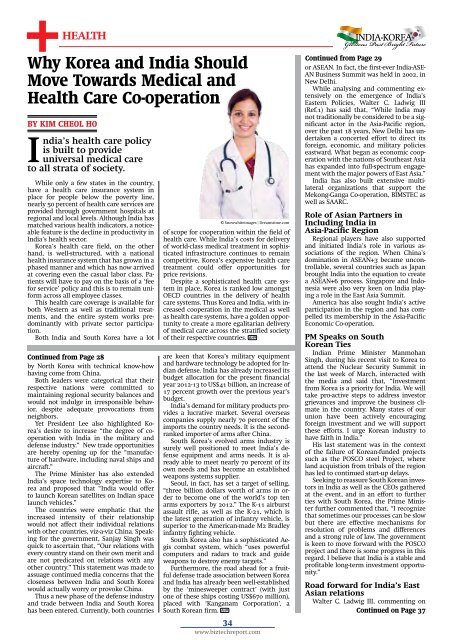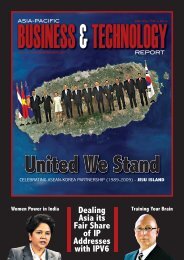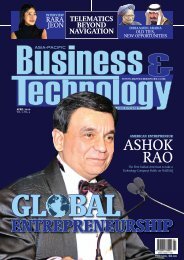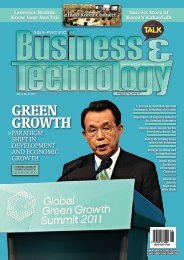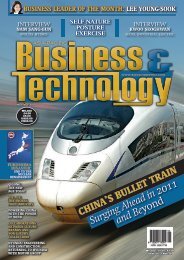INDIA-KOREA - Asia-Pacific Business and Technology Report
INDIA-KOREA - Asia-Pacific Business and Technology Report
INDIA-KOREA - Asia-Pacific Business and Technology Report
You also want an ePaper? Increase the reach of your titles
YUMPU automatically turns print PDFs into web optimized ePapers that Google loves.
health<br />
Why Korea <strong>and</strong> India Should<br />
Move Towards Medical <strong>and</strong><br />
Health Care Co-operation<br />
by Kim Cheol Ho<br />
India’s health care policy<br />
is built to provide<br />
universal medical care<br />
to all strata of society.<br />
While only a few states in the country,<br />
have a health care insurance system in<br />
place for people below the poverty line,<br />
nearly 50 percent of health care services are<br />
provided through government hospitals at<br />
regional <strong>and</strong> local levels. Although India has<br />
matched various health indicators, a noticeable<br />
feature is the decline in productivity in<br />
India’s health sector.<br />
Korea’s health care field, on the other<br />
h<strong>and</strong>, is well-structured, with a national<br />
health insurance system that has grown in a<br />
phased manner <strong>and</strong> which has now arrived<br />
at covering even the casual labor class. Patients<br />
will have to pay on the basis of a ‘fee<br />
for service’ policy <strong>and</strong> this is to remain uniform<br />
across all employee classes.<br />
This health care coverage is available for<br />
both Western as well as traditional treatments,<br />
<strong>and</strong> the entire system works predominantly<br />
with private sector participation.<br />
Both India <strong>and</strong> South Korea have a lot<br />
Continued from Page 28<br />
by North Korea with technical know-how<br />
having come from China.<br />
Both leaders were categorical that their<br />
respective nations were committed to<br />
maintaining regional security balances <strong>and</strong><br />
would not indulge in irresponsible behavior,<br />
despite adequate provocations from<br />
neighbors.<br />
Yet President Lee also highlighted Korea’s<br />
desire to increase “the degree of cooperation<br />
with India in the military <strong>and</strong><br />
defense industry.” New trade opportunities<br />
are hereby opening up for the “manufacture<br />
of hardware, including naval ships <strong>and</strong><br />
aircraft.”<br />
The Prime Minister has also extended<br />
India’s space technology expertise to Korea<br />
<strong>and</strong> proposed that “India would offer<br />
to launch Korean satellites on Indian space<br />
launch vehicles.”<br />
The countries were emphatic that the<br />
increased intensity of their relationship<br />
would not affect their individual relations<br />
with other countries, viz-a-viz China. Speaking<br />
for the government, Sanjay Singh was<br />
quick to ascertain that, “Our relations with<br />
every country st<strong>and</strong> on their own merit <strong>and</strong><br />
are not predicated on relations with any<br />
other country.” This statement was made to<br />
assuage continued media concerns that the<br />
closeness between India <strong>and</strong> South Korea<br />
would actually worry or provoke China.<br />
Thus a new phase of the defense industry<br />
<strong>and</strong> trade between India <strong>and</strong> South Korea<br />
has been entered. Currently, both countries<br />
© Snowwhiteimages | Dreamstime.com<br />
of scope for cooperation within the field of<br />
health care. While India’s costs for delivery<br />
of world-class medical treatment in sophisticated<br />
infrastructure continues to remain<br />
competitive, Korea’s expensive health care<br />
treatment could offer opportunities for<br />
price revisions.<br />
Despite a sophisticated health care system<br />
in place, Korea is ranked low amongst<br />
OECD countries in the delivery of health<br />
care systems. Thus Korea <strong>and</strong> India, with increased<br />
cooperation in the medical as well<br />
as health care systems, have a golden opportunity<br />
to create a more egalitarian delivery<br />
of medical care across the stratified society<br />
of their respective countries. A-P<br />
are keen that Korea’s military equipment<br />
<strong>and</strong> hardware technology be adopted for Indian<br />
defense. India has already increased its<br />
budget allocation for the present financial<br />
year 2012-13 to US$41 billion, an increase of<br />
17 percent growth over the previous year’s<br />
budget.<br />
India’s dem<strong>and</strong> for military products provides<br />
a lucrative market. Several overseas<br />
companies supply nearly 70 percent of the<br />
imports the country needs. It is the secondranked<br />
importer of arms after China.<br />
South Korea’s evolved arms industry is<br />
surely well positioned to meet India’s defense<br />
equipment <strong>and</strong> arms needs. It is already<br />
able to meet nearly 70 percent of its<br />
own needs <strong>and</strong> has become an established<br />
weapons systems supplier.<br />
Seoul, in fact, has set a target of selling,<br />
“three billion dollars worth of arms in order<br />
to become one of the world’s top ten<br />
arms exporters by 2012.” The K-11 airburst<br />
assault rifle, as well as the K-21, which is<br />
the latest generation of infantry vehicle, is<br />
superior to the American-made M2 Bradley<br />
infantry fighting vehicle.<br />
South Korea also has a sophisticated Aegis<br />
combat system, which “uses powerful<br />
computers <strong>and</strong> radars to track <strong>and</strong> guide<br />
weapons to destroy enemy targets.”<br />
Furthermore, the road ahead for a fruitful<br />
defense trade association between Korea<br />
<strong>and</strong> India has already been well-established<br />
by the ‘minesweeper contract’ (with just<br />
one of these ships costing US$670 million),<br />
placed with ‘Kanganam Corporation’, a<br />
South Korean firm. A-P<br />
34<br />
www.biztechreport.com<br />
<strong>INDIA</strong>-<strong>KOREA</strong><br />
Glorious Past Bright Future<br />
Continued from Page 29<br />
or ASEAN. In fact, the first-ever India-ASE-<br />
AN <strong>Business</strong> Summit was held in 2002, in<br />
New Delhi.<br />
While analysing <strong>and</strong> commenting extensively<br />
on the emergence of India’s<br />
Eastern Policies, Walter C. Ladwig III<br />
(Ref.1) has said that, “While India may<br />
not traditionally be considered to be a significant<br />
actor in the <strong>Asia</strong>-<strong>Pacific</strong> region,<br />
over the past 18 years, New Delhi has undertaken<br />
a concerted effort to direct its<br />
foreign, economic, <strong>and</strong> military policies<br />
eastward. What began as economic cooperation<br />
with the nations of Southeast <strong>Asia</strong><br />
has exp<strong>and</strong>ed into full-spectrum engagement<br />
with the major powers of East <strong>Asia</strong>.”<br />
India has also built extensive multilateral<br />
organizations that support the<br />
Mekong-Ganga Co-operation, BIMSTEC as<br />
well as SAARC.<br />
Role of <strong>Asia</strong>n Partners in<br />
Including India in<br />
<strong>Asia</strong>-<strong>Pacific</strong> Region<br />
Regional players have also supported<br />
<strong>and</strong> initiated India’s role in various associations<br />
of the region. When China’s<br />
domination in ASEAN+3 became uncontrollable,<br />
several countries such as Japan<br />
brought India into the equation to create<br />
a ASEAN+6 process. Singapore <strong>and</strong> Indonesia<br />
were also very keen on India playing<br />
a role in the East <strong>Asia</strong> Summit.<br />
America has also sought India’s active<br />
participation in the region <strong>and</strong> has compelled<br />
its membership in the <strong>Asia</strong>-<strong>Pacific</strong><br />
Economic Co-operation.<br />
PM Speaks on South<br />
Korean Ties<br />
Indian Prime Minister Manmohan<br />
Singh, during his recent visit to Korea to<br />
attend the Nuclear Security Summit in<br />
the last week of March, interacted with<br />
the media <strong>and</strong> said that, “Investment<br />
from Korea is a priority for India. We will<br />
take pro-active steps to address investor<br />
grievances <strong>and</strong> improve the business climate<br />
in the country. Many states of our<br />
union have been actively encouraging<br />
foreign investment <strong>and</strong> we will support<br />
these efforts. I urge Korean industry to<br />
have faith in India.”<br />
His last statement was in the context<br />
of the failure of Korean-funded projects<br />
such as the POSCO steel Project, where<br />
l<strong>and</strong> acquistion from tribals of the region<br />
has led to continued start-up delays.<br />
Seeking to reassure South Korean investors<br />
in India as well as the CEOs gathered<br />
at the event, <strong>and</strong> in an effort to further<br />
ties with South Korea, the Prime Minister<br />
further commented that, “I recognize<br />
that sometimes our processes can be slow<br />
but there are effective mechanisms for<br />
resolution of problems <strong>and</strong> differences<br />
<strong>and</strong> a strong rule of law. The government<br />
is keen to move forward with the POSCO<br />
project <strong>and</strong> there is some progress in this<br />
regard. I believe that India is a stable <strong>and</strong><br />
profitable long-term investment opportunity.”<br />
Road forward for India’s East<br />
<strong>Asia</strong>n relations<br />
Walter C. Ladwig III, commenting on<br />
Continued on Page 37


